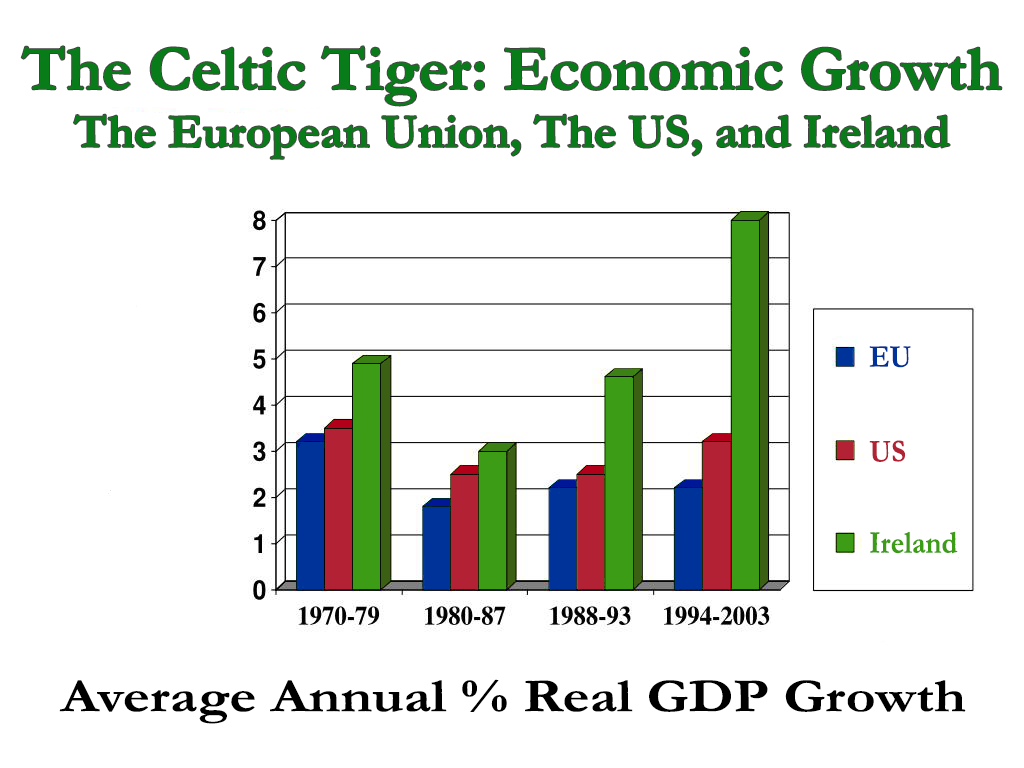IRISH HISTORY SINCE 1850
The Celtic Tiger
For most of its existence, the Irish Republic had been a relatively poor, undermodernized nation. Although joining the European Union in 1973 bolstered the Irish economy, the 1980s saw another period of downturn and high levels of emigration. In the 1980s the Irish unemployment rate was 18 per cent. In the 1990s the Irish Republic underwent a staggering period of economic growth and became one of the fastest growing economies in Europe.
In 1994 economist and broadcaster, David McWilliams, drew analogies between the situation in Ireland and what had happened in countries such as Hong Kong and South Korea a decade earlier, and coined the phrase the Celtic Tiger. This shorthand way of describing the boom in Ireland became a popular term for summing up what was happening in the country.
As well as all the economic modernization, Ireland also underwent many social changes. For the first time since the famine of the mid-nineteenth century emigration stopped. People began turning away from the Church, and began demanding more liberal attitudes towards divorce and abortion. With higher disposable incomes, the Irish also became big consumers, and city centers, especially Dublin, were transformed by the opening of an endless array of restaurants, bars, and nightclubs.

Ireland Gets Rich
From being the poor men of Europe in the 1980s, Ireland became the rich man. Between 1991 and 2003 its economy grew by an amazing 6.8% per year, and Irish living standards became amongst the highest in Europe.
The Irish are famous for having emigrated to the four corners of the world. That trend continued well into the 1980s, but since the advent of the Celtic Tiger, outward emigration has largely stopped. What has begun happening, for the first time ever is that large numbers of immigrants have begun arriving in Ireland. Immigrants from African and Eastern European nations have arrived in Ireland seeking to benefit from the wealth of the country. While there have been many positive aspects to this inward movement of people, there has also been a rise in racism among many sectors of the Irish population.
Ireland got rich by having a very low corporate tax rate, and by encouraging a whole series of multinational companies to locate in the country. Ireland was particularly successful in attracting high technology companies, and is now one of the biggest producers of computers in Europe. It also helped that Irish workers were relatively cheap to employ, but very highly skilled.
The success soon became apparent. During the 1990s the property market soared, consumer spending boomed, and by 2005 unemployment was a mere 4.2 per cent. As the government was careful to use its new found wealth to 360 Part VI: Divided in Two: Life from the 1880s cut public debt, it has also been able to invest money in major renewal projects such as the Luas tramway system in Dublin.
While many people in Ireland have got rich in recent years, there are still areas of high social deprivation in the country. In some of the Dublin city suburbs crime rates and drug use remain high, as do the levels of poverty and unemployment. Schemes are in place to try and equalize the spread of wealth throughout the country, but it's clear that not everyone benefited from the Celtic Tiger.